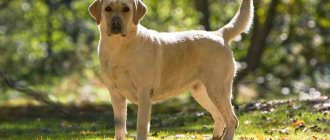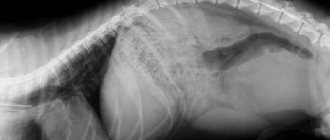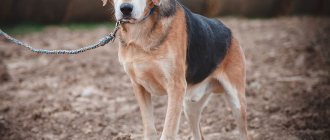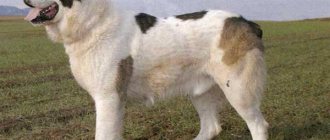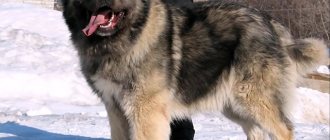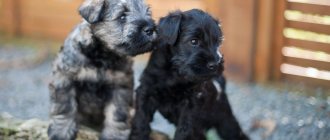Pugs are a breed that is classified as small dogs (the average height at the withers reaches 30 cm).
The color of pugs can be different - silver, apricot, beige or black.
With a muscular build, the pug is the strongest representative of the dwarf dogs.
Also having a large head, a folded muzzle, large eyes that look into the very soul, and a tail tightly curled to the croup, he will not leave anyone indifferent.
In the article we will look at how many years pugs live and what factors influence their life expectancy.
Brief information about the breed
Representatives of this breed are friendly and active. They are also very loyal to their owner and follow him everywhere. They get along well with children, patiently putting up with their pranks, and get along with all pets, such as cats, rabbits, other dogs, and so on.
The Pug is very brave and is one of those small dogs who believe that the best form of defense is attack. Therefore, he will fearlessly rush to protect his owner in case of danger, barking loudly.
Read more detailed characteristics of pugs here.
Life expectancy of pugs
The average Bobik of noble breeds can easily live from 10 to 15 years. With dogs, in whose veins pure blood flows with a rich pedigree, everything is much more complicated. For example, if a dog weighs more than 60 kg and is almost as tall as its owner, you shouldn’t expect it to celebrate its 10th birthday. With small decorative dogs, everything happens exactly the opposite: the smaller they are, the longer they live.
Pugs belong to the category of decorative dogs and their height rarely exceeds 30 cm. These cute, goggle-eyed fat dogs can live, as befits all small dogs, up to 15 years. Because of this, they were even included in the top 10 long-lived dogs. Interestingly, female representatives of the breed usually live much longer than males. Whether this is due to the fact that females have a more docile character and are less likely to get into fights or because they have better immunity is not known, but the fact remains a fact.
Lifespan of dogs
With proper care and absence of diseases, the average life expectancy of a pug is 12-15 years.
To determine the age of your pet in relation to a human, use this table:
| Dog age, number of years | Person's age, <number of years |
| 1 | 15 |
| 2 | 23 |
| 3 | 28 |
| 4 | 32 |
| 5 | 36 |
| 6 | 40 |
| 7 | 44 |
| 8 | 48 |
| 9 | 52 |
| 10 | 56 |
| 11 | 60 |
| 12 | 64 |
| 13 | 68 |
| 14 | 72 |
| 15 | 76 |
| 16 | 80 |
NOTE!
Like people, girls of this breed usually live longer than boys, as they are more careful, unlike males, who can get injured due to their excessive activity.
Average life expectancy at home
The lifespan of dogs depends on many factors. Among them:
- Breed.
- Quality of pet care.
- Living conditions (in a room, in an enclosure, free range).
- Presence of congenital diseases.
- Heredity and general health.
- Character traits (active or lazy dog).
The average life expectancy of four-legged friends varies from 11 to 13 - 17 years. There are also long-lived dogs: over 19 years.
Different breeds have different maturation periods. So, a Chihuahua puppy at 5 months is already a full-fledged dog that is ready for mating, and an English Mastiff puppy will become an adult only by 2 years. The following are approximate data for the ratio of human and dog ages. The first column is the age of the dog, the second is the age of the person:
- 12 weeks – 5 years.
- 18 months – 20 years.
- 3 years – 28 years.
- 5 years – 36 years.
- 9 years – 52 years.
- 12 years – 64 years.
- 15 years – 76 years.
So, 10 years or more is the retirement age for any breed. From this time on, the pet requires increased attention and enhanced care.
How to extend the life of a pet?
There are several rules that will contribute to a long life of a pug, making it better and happier.
These include:
- conducting regular games with your pet in order to avoid problems with blood circulation and atrophy;
- maintaining a properly balanced diet, which must contain vitamins A, B, E and C, which slow down the aging process of the pug’s body;
- coordinating walks with the weather, since pugs do not tolerate heat well, so you should walk in the summer early in the morning or in the evening, when there is no heat, you should also avoid hypothermia in frosty weather (you can use clothes for dogs);
- Carrying out an examination of the dog after walks, paying special attention to the eyes, which are often injured, exposed to mosquito bites and simply dust;
- performing hygiene procedures, such as wiping skin folds, cleaning teeth and ears;
- maintaining moderate exercise to keep the pug in good shape;
- visiting a veterinarian and following the vaccination schedule;
It is also important to give positive emotions, since pugs are very sensitive and sincerely devoted to their owner, they need love and care.
What do they die from?
How long pug dogs live depends on related factors. To prevent possible diseases and pathologies, owners must know how to care for their dog.
Weak heart
Heart problems can be either acquired or congenital. The puppy may inherit the disease or be obese. The first symptom of excess weight is shortness of breath. It begins to appear even during normal walking or while resting. You need to show your pet to a veterinarian, reduce the amount of physical activity and ensure proper rest.
Excess weight
Pugs prefer a domestic lifestyle, they sleep a lot and are rarely overly active. If the owners do not devote enough time to walks, the animal is at risk of obesity. Due to excess weight, the respiratory, digestive and cardiovascular systems suffer.
Respiratory system
The respiratory system of brachycephalic dogs is designed in such a way that it is difficult for them to breathe in hot and cold weather. That's why pugs sometimes grunt and sneeze. Sometimes pathologies of the skull may occur, which aggravate the problems and provoke various diseases.
Note! Walking pugs in windy weather can provoke the development of a respiratory infection.
Infections
Skin infections most often occur due to the accumulation of dirt in the folds of the skin and poor hygiene. Bacteria can cause inflammation, suppuration and dermatitis. Owners should monitor the health of their dog's skin and promptly treat any damage.
Bad heredity
There are diseases that are inherited and can shorten a pet’s life:
- Encephalitis is an incurable disease that manifests itself in the form of convulsions and the release of foaming saliva, which indicates a seizure. Death can occur at any age. It is possible to verify the absence of the disease only with the help of a DNA test;
- dislocation of the kneecap , which in itself does not affect the life expectancy of the pug, but requires surgical treatment using anesthesia, which puts a strain on the heart;
- joint destruction caused by lack of blood circulation can shorten a dog's life by half;
- hip dysplasia , which requires treatment with medications (painkillers, anti-inflammatory) that weaken the heart.
IMPORTANT!
To avoid these inherited diseases, you should carefully select a dog from a breeder. Ask if his parents were sick and how long they lived.
What factors influence life expectancy
The longevity of pugs depends on genetic inheritance and living conditions. Pugs are a type of brachycephalic breed, characterized by a short muzzle, soft palate, narrowed nostrils and ear canals. These dogs are predisposed to a number of diseases that shorten their lifespan:
- Hereditary diseases - necrosis of the femoral head, early puppy Peters disease, appears at the age of 4-10 months.
- Weak cardiovascular system.
- Obesity, which impairs the functioning of the liver and heart.
- Ophthalmological diseases caused by the structural features of the pug's muzzle (short).
- Juvenile demodicosis, caused by the Demodex canis mite against the background of decreased immunity. It is expressed by hair loss and thinning.
- Diseases of the hearing aid due to the specific structure of the ear canal.
- Diseases of the musculoskeletal system.
Major diseases and how to avoid them
The number of years a pug will live is affected by a number of diseases that are characteristic of this breed due to its special structure.
Heart problems
Almost all representatives of this breed have a rather weak heart. Pugs do not tolerate heat and sudden temperature changes.
The dog may also die due to cardiac arrest due to increased activity. It is necessary to monitor your pet's exercise and breathing, avoiding shortness of breath.
Diseases of the sense organs
The pug's gaze seems deep, understanding and sweet. This is because the eyes of this breed are bulging. They simply do not have enough space in the skull - they are always protruding. Therefore, the weakest and most vulnerable place of a pug is the eyes.
Keratoconjunctivitis sicca is not a rare disease that occurs due to low tear production. This disease leads to redness and inflammation of the dog's eyes.
Due to infection, further development into entropion (curling of the edge of the eyelid towards the eye), which causes irritation of the cornea, inflammation of the eyelids and severe pain, is possible. The disease can affect both eyes or just one. Treatment occurs through surgery, but to carry it out it is important to contact a veterinarian in a timely manner.
Due to the structure of the skull, pugs' eyes can also fall out.
Ear disease – otitis – is quite common in this breed. The dog is restless and constantly tries to scratch its sore ear, shaking its head. If you do not pay attention to these symptoms in time and do not start treatment, you may experience an increase in temperature and the release of unpleasant-smelling mucus from the ears. This disease is treated using specialized ear drops.
Diseases of the gastrointestinal tract
Ulcers and gastritis are more common. However, it could also be a simple food allergy.
The most common manifestation of such diseases is vomiting, in very severe situations with blood. To return your pet to a normal state, you need to introduce some restrictions on the diet, replacing regular food with oatmeal porridge cooked in water.
If there is no improvement, contact a specialist to prescribe medications.
Skin rashes
Such diseases include juvenile demodicosis, which causes itching, due to which the pug itches and licks itself all the time. The symptoms are similar to allergies, but with demodicosis, small pimples with dark spots in the middle appear on the skin of the abdomen.
It is worth noting that with allergies, dogs sometimes scratch the problem area until it bleeds. Therefore, it is important to start treatment early. The cause of the disease may be food, the material from which the bedding or collar is made. Pollen allergies are much less common.
Obesity
This is the most common and typical problem that arises due to the fault of the owners who overfeed the pug, succumbing to the pet’s “persuasion” for supplements. Obesity causes complications in the heart, hind limbs, lungs and liver.
NOTE!
To avoid all these diseases, you must follow the rules of caring for your dog, as well as choose the right food.
Diseases and infections that shorten the life of a pug
- Congenital diseases and genetic abnormalities are a risk that is most often discovered in adulthood after one year of age. The dog begins to waste away and upon examination it becomes clear, for example, that there is a heart defect. There is no way to avoid this, because even an authorized mating can produce a litter with defects, even if they concern only the internal characteristics of the puppies.
- Fungal and infectious diseases in skin folds. The folds themselves, if properly cared for, do not pose an additional risk to the life of the pug, but if you neglect to clean them, and the dog is accidentally injured, then even a small wound can become a source of infection.
- Tumors. Cancer, fibroma, myoma - all this, if it does not take the life of the animal soon after its appearance, will certainly complicate its further existence, attracting other diseases to the weakened body. If the tumor is operable, then it is better to remove it and not wait for it to grow or degenerate into cancer. Typically, the life expectancy of pugs with cancerous tumors and diseases is halved.
Encephalitis tick bite. If you are a good owner and you walk your pug not only on stone sidewalks, but play with him in parks, on lawns, or take him out of town for a joint vacation, then you always run the risk of bringing a tick on his fur. It is important to check the dog daily for the presence of attached ticks, and if a pest is still found, then remove it only from a doctor, and then submit the pest for analysis. Encephalitis causes inflammation and fatal swelling of the brain, so even if the tick did not bite the skin deeply, you were able to completely remove it from the skin, still take the tick for examination.
- Aseptic necrosis of the femoral head or Legg-Calvé-Perthes disease. The disease develops in the presence of internal pathology in the blood supply to the joint, which begins the process of inflammation and necrosis. Pugs with this disease die at the age of 7-8 years.
- Diabetes - the disease itself does not pose a particular threat to the life expectancy of a pug, but improper care, diet and neglect to monitor the disease at the veterinarian can lead to fatal complications.
INTERESTING: there is a note about long-lived pugs in the Guinness Book of Records. The oldest of these dogs is the American pug KingTug, who lived for 18 years.
Proper nutrition
There are two opinions about what to feed your pet.
A diet based on natural products is very difficult to follow, since the pug must receive all the necessary vitamins.
If you choose this diet, then follow these recommendations:
- the dog always has water available;
- food at room temperature;
- food is not liquid;
- Most of the diet is meat;
- small amount of salt.
Dogs should not eat:
- pork:
- sugar;
- sausages;
- fried food;
- spices;
- fatty broth;
- bones;
- I'm eating from the owner's table.
It is easier to maintain food intake, since it already contains the substances the dog needs. This feeding option also saves you time.
However, we must remember that it is strictly prohibited:
- alternate food from different companies;
- pour boiling water over it;
- combine with natural feeding.
Features of the pug breed
For the first time, pugs were brought from Asia to France and Holland, and at first these dogs were considered created only for royalty.
This is due to the fact that Queen Victoria of England also kept several pugs, which contributed to the development of selection of this breed. Pugs are medium-sized dogs with strong, well-developed muscles, short hair and a short, flattened muzzle. Height at the withers ranges around 30 cm, and weight averages from 8 to 10 kg.
Due to the fact that dogs' faces have a special structure, their breathing is quite noisy, and some physiological characteristics of the breed contribute to a number of diseases. As a rule, these are problems with the heart and blood vessels, vision and joints.
Representatives of these breeds are rarely kept in their own homes in the yard, since sudden temperature changes can lead to irreversible consequences.
Statistically, female pugs live longer than male pugs. But this has nothing to do with their health. Girls are more flexible and obedient. They rarely participate in fights where they can get injured. Male pugs are more willful.
Try to buy a puppy that was the first in the litter. He will have stronger immunity than his siblings.
Content Rules
Pugs are difficult to classify as whimsical dogs, the main thing is:
- see a veterinarian;
- follow the vaccination schedule;
- choose the right diet rich in vitamins;
- walk in the morning and evening;
- spend a lot of time together.
Expert opinion
Kozhevin Semyon Kirillovich
Expert dog handler.
Since dogs of this breed are prone to obesity, you need not only to properly balance the diet, but also to walk your pet a lot. It is also very important to take care of your eyes: this is their sore spot, prone to injury. But the most important thing is to love, because a pug stands for a small, very loyal dog.
dog's heart
The owner's negligence in caring for it can shorten the dog's life. Vulnerable places in the pug’s body are:
- eyes (due to the risk of injury and loss of the eyeball);
- nose (due to the abundance of folds under it);
- ears (narrow ear canal).
If you don’t take care of the folds on the dog’s face, take care of the eyes, and don’t clean the dog’s ears, serious illnesses may develop that will have to be treated with medication. And taking them can lead to the development or exacerbation of allergies - a real mortal danger for dogs of this breed.
Now more about the heart. Unfortunately, in pugs it is very weak. That is why they have a hard time withstanding the heat and suffer from shortness of breath. An overly active dog, not calculating its strength, can die from cardiac arrest during play. Therefore, the owner must monitor his condition and not let him overwork. Quite often, a dog’s heart cannot withstand anesthesia during surgery, and then the animal dies, even when it is very young.
When wondering how long pugs live, it’s worth remembering about viral diseases. Both a small puppy and an adult dog can die from them. Therefore, it is necessary to get vaccinations in a timely manner and be observed by a veterinarian.
Inspection after the walk
In order to prevent the development of various problems, the pug owner needs to develop the habit of carefully examining his dog after walks.
We suggest you read: Who to choose - a French bulldog or a pug
During the summer, it is imperative to check your dog for ticks.
Regardless of the time of year, after a walk you need to carefully examine your dog’s eyes.
It is they who are often exposed to various injuries and infectious diseases in pugs. On the street, a pug can injure the mucous membrane of the eye even with a dry blade of grass.
Also, the dog's eyes are often exposed to insect bites. If, after a walk, wounds, cuts or scratches are found on the eyelids or mucous membranes, regenerating drops should be applied to the eyes.
At the same time, owners need to know that eye drops containing hormones are absolutely not suitable for caring for pugs.



